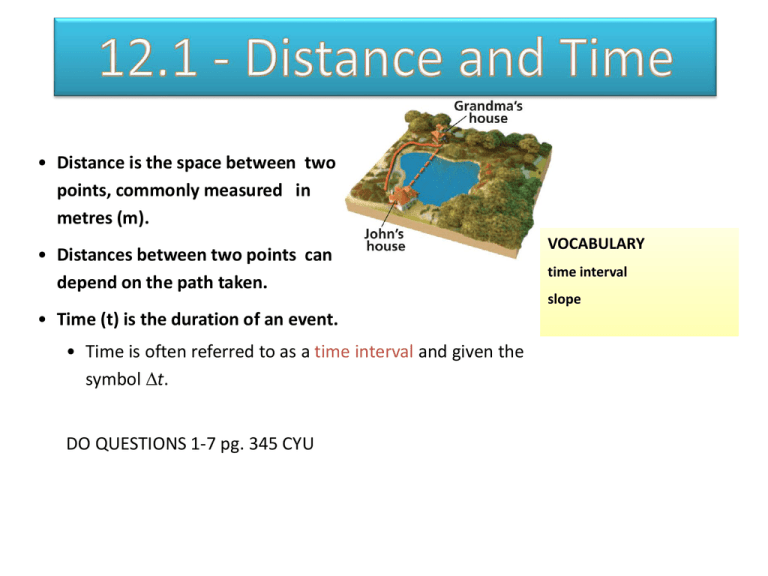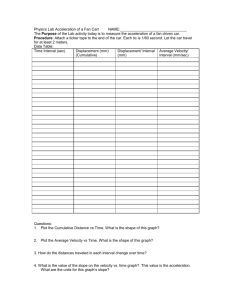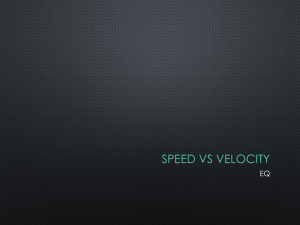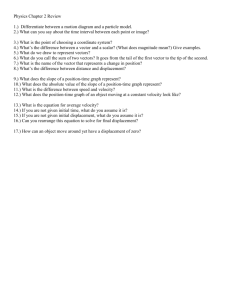CH12 Power
advertisement

12.1 • Distance is the space between two points, commonly measured in metres (m). • Distances between two points can depend on the path taken. • Time (t) is the duration of an event. • Time is often referred to as a time interval and given the symbol t. DO QUESTIONS 1-7 pg. 345 CYU VOCABULARY time interval slope Answers 12.1-CYU #1-7 1. A. Year, B. Minute, C. second D. Hour E. Day or week or Month 2. Distance is the length of the path along which an object moves 3. The distance would be difficult to measure again 4. Y is shorter, x is 2200 m long and y is 1655 m long therefore 545 m shorter 5. A time interval is the difference between an ending time and a starting time 6. 2820 s 7. Starting time and ending time are needed to measure a time interval • A period (T ) is the time interval between two repeating events, such as a pendulum swinging. • It is related to frequency as: Read Sample Problem #1 p. 343 then DO CYU #8-10 p. 345 Answers 2.1-CYU #8-10 8. T = 0.25 s; f= 4 Hz 9. T = 2.8 s; f=0.36 Hz 10. T = 0.005 s Next Day – you will be gathering data for a two part lab 1. Determine the Length of a Pendulum with a Period of one Second 2. Does the mass of the Pendulum effect the Period 12.2 • By relating time and distance, we can determine speed, which is the distance an object travels (d) divided by the time interval (t). • The average speed of an object is the total distance the object travelled divided by the total time taken. • Instantaneous speed is the speed of an object at a particular instant in time. • For example, a car speedometer reads instantaneous speed. • For an object travelling at a constant speed (i.e. uniform motion), the average speed is equal to its instantaneous speed. VOCABULARY speed average speed instantaneous speed Graphs are used to illustrate the mathematical relationships of two quantities. ***Be sure to really think about what the graph ACTUALLY represents*** Recall x is always the independent variable and y is the dependant variable 12.3 Graphing Distance and Time • A distance–time graph has distance on the y-axis and time on the x-axis. • The slope of a line on a distance– time graph is equal to average speed. • The units for the slope would be metres/second (m/s), the same as speed. Do CYU 12.2 p. 350 CYU 12.2 Answers #1-14 1. 2. A. 1.7 m/s B. 0.55 m/s C. 0.82 m/s VAV for the trip was 56 km/h ; VAV while the car was moving was 96 km/h 3. 19.1 m/s 4. A. 113 cm. B. 113 cm/m or 1.9 cm/s C. Yes, the instantaneous speed is not changing 5. 1.7 s 12. A. About 42000 km B. 1.5 h 6. 0.44 s 7. 6.1 x 10-3 s 13. The average speed of object can change over 8. 4.0 x 102 m time. It depends only on the distance travelled and the time interval. The constant speed remains the 9. 380 km same throughout the time interval 10. 6 min 40 s 11. 2.25 km 14. 65 km/h 12.3 • We can calculate the instantaneous speed of an object at a particular time by calculating the slope of the tangent to the line of the distance– time graph of the object’s motion. • Just as we can use distance and time data to construct a graph, we can derive information about distance, time, and speed from a graph. Calculate: 1. The distance travelled between t=0.5hr and t=1.25 hr 2. The average speed over the first 1.75 hr 3. The speed the car is travelling at at t= 0.25 hr and also t = 2.25 hr 4. In words write a description of the cars movement over the 2.5 hr interval in terms of speed, time and distance Answers to Practice Q’s 1. Df – Di = 90km – 50km = 40 km 2. = Df – Di / tf – ti = (90km - 0 km) / (1.75s – 0s) = 51km/s 3. Calculate the slope of the line at this time since it is constant there! At t = 0.25s the speed is: 75km.0.75s = 100 km/s however at t = 2.25s (100-90) / (21.75) = 40 km/s 4. The car traveled at a constant speed of 100 km/s for the first 0.75 s, then slowed to a constant speed of for the next 0.25 s before stopping for 0.75 s. In the end the car was travelling at a constant speed of 40km/s Answers to 12.3 CYU #1-5 1. 2. 3. 4. 5. A. The graph shows time from 0-7 s along the horizontal axis and a distance from 0 to 35 m on the vertical axis B. 4.4 m/s C. 4 m/s D. The first second E. The third second The graph would be a straight line slanting upward to the right A. 42 km/h B. 88 km/h C. Yes the graph of its motion is a straight line Draw a tangent to the line of motion at a certain time and calculate its slope A. For the first 2 s, the butterfly flies quickly to a point, gradually slows over the next 2 s, and then stops for 2 s. The butterfly then flies at a slower but almost constant speed for 4 s. B. 6.8 cm/s C. At 2 s, v = 10 cm/s; at 5.5s, v = 0; at 9s, v = 5cm/s 12.4-Displacement, Time, and Velocity • Quantities can be either scalar or vector. • Scalar quantities only have magnitude, which is a number with a unit. • Vector quantities have both a magnitude and a direction. • An object’s speed and velocity can be described in different ways. • For example, average speed or velocity, instantaneous speed, and uniform motion (constant speed or velocity). 12.4 Displacement and Velocity • Distance and displacement are similar, but not identical concepts in science. VOCABULARY scalar quantity displacement • Distance is a scalar quantity (magnitude only). vector quantity • Displacement is a vector quantity (magnitude and direction) velocity • The displacement of an object is its change in position in relation to a point of reference. uniform motion 12.4Displacement, Time, and Velocity 1 • The motion of an object can be described by displacement, time, and velocity. • Distance and displacement are similar but not identical concepts in science. • Speed and velocity are also similar but not identical concepts. 12.4 Displacement and Velocity • Speed and velocity are also similar, but not identical concepts. VOCABULARY scalar quantity • Speed is a scalar quantity (magnitude only). displacement • Velocity is a vector quantity (magnitude and direction). vector quantity velocity • Velocity is the rate of change of displacement and is given by the equation: • The slope of the line of a position– time graph is equal to the velocity of the object. uniform motion CHAPTER 12 Displacement, Time, and Velocity • Distance–time graphs and position–time graphs can visually display information about an object’s motion. • The slope of the line is equal to the speed or velocity of the object. • If the slope of the line is changing, the speed or velocity is not constant. • If the slope the line is constant, the object is travelling at constant speed or velocity. CHAPTER 12 Displacement, Time, and Velocity Activity • With a partner, use a mind map to brainstorm different methods of measuring distance (including length and height of objects). • For example, you could measure using a ruler, using the length of your arm, etc. • Could all of your distance measuring methods be converted to have the same measurement units, such as metres? • If you wanted to measure the distance from school to your home, which method would you use? Explain. • For more information on distance, read page 341 in the textbook. CHAPTER 12 Displacement, Time, and Velocity Key Ideas • The motion of an object can be described by displacement, time, and velocity. • Distance–time graphs and displacement–time graphs can visually display information about an object’s motion. • Quantities can be either scalar or vector. • An object’s speed and velocity can be described in different ways.








